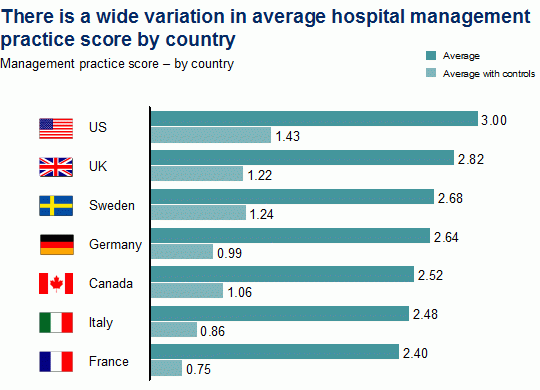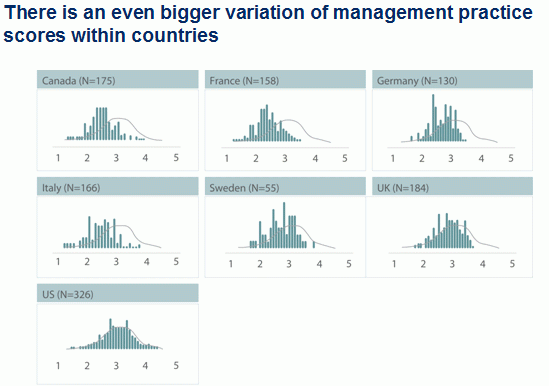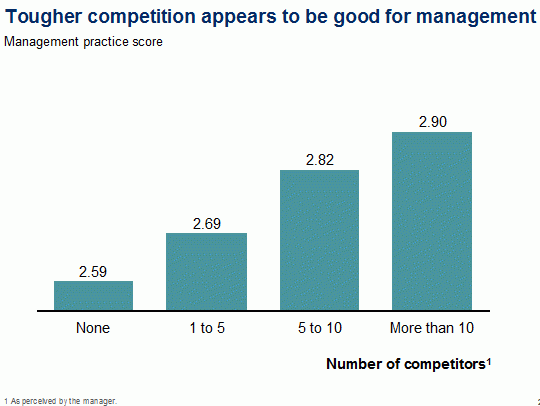On average, healthcare spending in OECD countries – and especially in the US – has outpaced GDP growth by nearly two percentage points a year, and this trend will continue to persist over time (Hall and Jones 2007). As the healthcare sector lags behind others in improving its productivity, it can also create a productivity drag on the economy overall. Although maintaining a good standard of healthcare provision has obvious welfare implications, our understanding of what causes differences in quality and productivity across hospitals continues to be relatively poor.
Differences in management practices have long been suspected as playing a role in explaining productivity differentials across companies. Despite this, we have traditionally lacked an accepted and comparative tool for analysing these effects. As part of our ongoing research agenda, we have addressed this gap in the literature by developing a methodology for quantifying management practices across companies. In previous studies, we have shown how better management practices are associated with higher productivity and other indicators of performance, such as return on capital employed, sales growth and firm survival rates (Bloom and Van Reenen 2010).
In our most recent round of research, we build on our existing methodology and assess the adoption of management practices across almost 1,200 hospitals in seven countries (Canada, France, Germany, Italy, Sweden, the UK, and the US). By combining the hospital-level management score with hospital-level outcome data we have shown that a strong relationship holds between hospital management and outcomes. Better managed hospitals tend to have better clinical outcomes, higher levels of patient satisfaction and enhanced financial performance. For example, in the UK, a one point improvement in our assessed management practice scores is associated with a 6% fall in the rate of deaths from heart attacks. While we cannot be sure that these are causal effects, the strength of the correlation suggests that management plays as much of an important role in healthcare as it does in industry.
Measuring management practices
We measure management practices using a team of trained analysts conducting interviews with unit or departmental managers in cardiology or orthopaedics units in hospitals providing acute care (short-term medical and/or surgical). To obtain accurate and unbiased responses, the analysts conduct “double blind” interviews with hospital managers. This means that managers are unaware of the scoring methodology and the criteria they are being scored against while the interviewers are unaware of the hospitals’ performance or other distinguishing features of the organisation in which they are conducting interviews.
The interviews cover management practices across three broad areas:
- Operations management. How standardised are main clinical procedures and how well is the clinical staff trained in these protocols?
- Performance and target management. How does the hospital set and track its main goals? How are these indicators reviewed? What are the consequences for failing to meet targets?
- People management. What systems are in place to recruit hospital staff? Does the hospital evaluate employees and reward based on performance? Is there an active promotion system that strives to maintain and incentivise employees?
The tool applied defines and scores from one (“worst practice”) to five (“best practice”) in 20 dimensions of practice across these three areas, with the management practice measure being an average of these 20 scores (for more details see Bloom and Van Reenen 2010 and Bloom et al. 2007).
Describing hospital management practices
Management practices vary considerably across countries, with the US scoring highest and Italy and France falling towards the bottom of the countries sampled. Even when controlling for known organisational distinctions, such as hospital size, age and ownership, these differences hold (see Figure1).
Though the differences across countries are striking, performance differences between hospitals in the same country are far larger than any cross-country variation (see Figure 2). Over 80% of the variation in management scores occurs across hospitals within the same country. This significant distribution of management practices within countries draws attention to possible drivers of these management practice disparities.
What drives hospital management around the world?
Our work identifies three main factors that account for much of these differences: Competition, scale, and skills. What is compelling is that these factors mirror similar results from our private sector work, highlighting a consistent set of factors that appear to be related to enhanced management.
Competition
One of the strongest findings from our manufacturing work is that competition stimulates better management and higher productivity. While enhanced competition has often been proposed as a solution that addresses the challenge of increasing hospital productivity, there is little consensus on the empirical evidence nor is there strong theoretical support that enhanced competition leads to improved outcomes.
We find strong evidence that hospitals that perceive to be facing more rivals are much better managed than those that consider fewer potential alternatives for patients to choose (See Figure 3). In our related research, we show that this positive effect of competition really is causal rather than driven by some other factor (Bloom et al. 2010)1, which strengthens our conclusion that competition has a large effect in improving management quality.
Scale
Hospital size makes a difference: larger hospitals, especially those with more than 100 direct employees exhibit much higher levels of management than smaller hospitals. This could reflect either economies of scale in management or the fact that that better managed hospitals tend to grow larger. Since there are strong regulatory constraints on hospital growth in most countries, the scale economies view is most plausible.
Skills
Our management findings also consistently highlight the impact of skills on management: hospitals with more clinically trained managers achieve higher management practice scores across all countries. Possible reasons for these results involve the impact of managers’ credibility and communication skills. Clinically trained managers are able to “speak the same language” as clinical staff, which not only enhances communication but also allows them to enjoy a level of credibility and authority difficult to achieve for non-clinical managers.
Closing the management gap
Though a persisting gap in management quality is just as evident in healthcare as it is in the private sector, our research highlights the substantial opportunity at hand to improve hospital efficiency through better management practices. The effect of these changes could be substantial. Placing causality aside, our research suggests that a one standard deviation increase in the proportion of clinical mangers (equivalent to a 25 percentage point increase) is linked to a 0.2 increase in management score. A standard deviation increase in either competition or size is associated with a 0.13 increase in management. The combined effect of an increase in these three factors could raise the management score by almost 0.5 points. This, in turn, would lead to significantly better patient outcomes (for example, around a 3% fall in death rates from emergency heart attacks).
For policymakers, the presence of competition seems to be a powerful mechanism for improvement, which reinforces calls for reform that encourage new entrants, allow for greater levels of patient choice and relax restrictions on hospital growth. Skills are another area of concern. Our research highlights the importance of having clinically trained mangers and also giving these managers greater levels of autonomy.
Finally, management is sure to be a key component of the performance transformation that hospitals must undertake if they are to improve their productivity and thus deliver improved care to patients worldwide.
For the full report see here. Hospitals and managers can also benchmark their own organisations through a free online tool here.
References
Bloom, Nicolas, Carol Propper, Stephen Seiler, and John Van Reenen (2010), “The impact of competition on management quality: evidence from public hospitals”, NBER Working Paper 16032.
Bloom, Dorgan, Dowdy, Genakos, Sadun, and Van Reenen (2007) “Management Practices and Productivity.” Centre for Economic Performance.
Bloom and Van Reenen (2010), “Why do Management Practices Differ across Firms and Countries?”, Journal of Economic Perspectives, 24(1):204-224.
Gaynor, Martin, Rodrigo Moreno-Serra, and Carol Propper (2010), “Death by Market Power: Reform, Competition, and Patient Outcomes in the National Health Service”, NBER Working Paper 16164.
Hall, Robert and Chad Jones (2007), “The Value of Life and the Rise in Health Spending”, Quarterly Journal of Economics, 122(1), 39-72.
1 Competition in healthcare is based on geography. In England, some areas have more hospitals for political reasons that are independent of health needs, as it is hard to close hospitals in politically marginal areas, we can use this as a natural experiment and show that, all else equal, hospitals located in marginal constituencies are much less likely to be closed than hospitals in safe seats. This strengthens our conclusion that competition has a large effect in improving management quality in hospitals. (See also Gaynor et al. 2010.)










